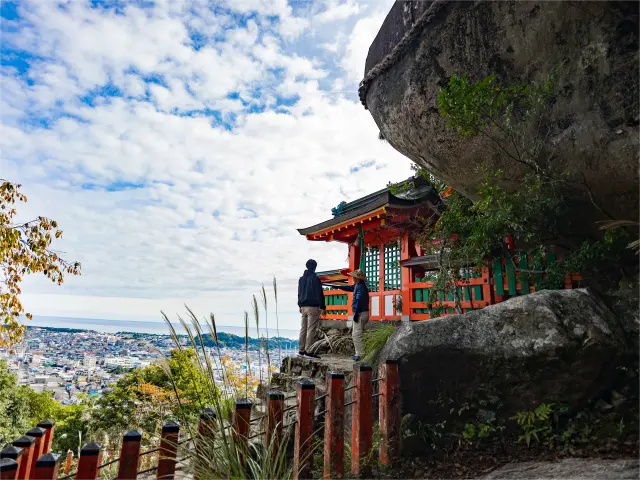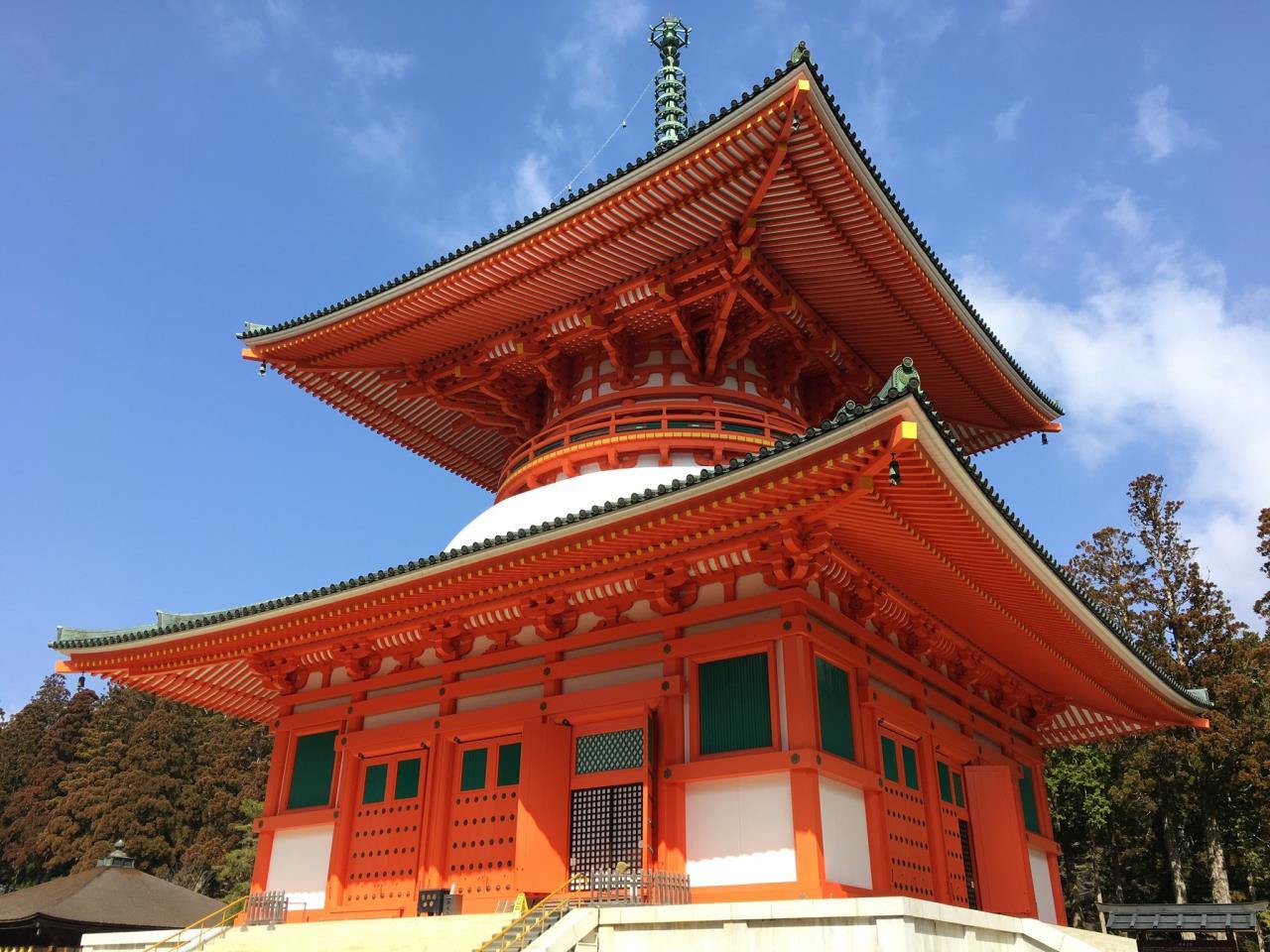
Castles, Temples and Gardens in Wakayama, day 3
Last update
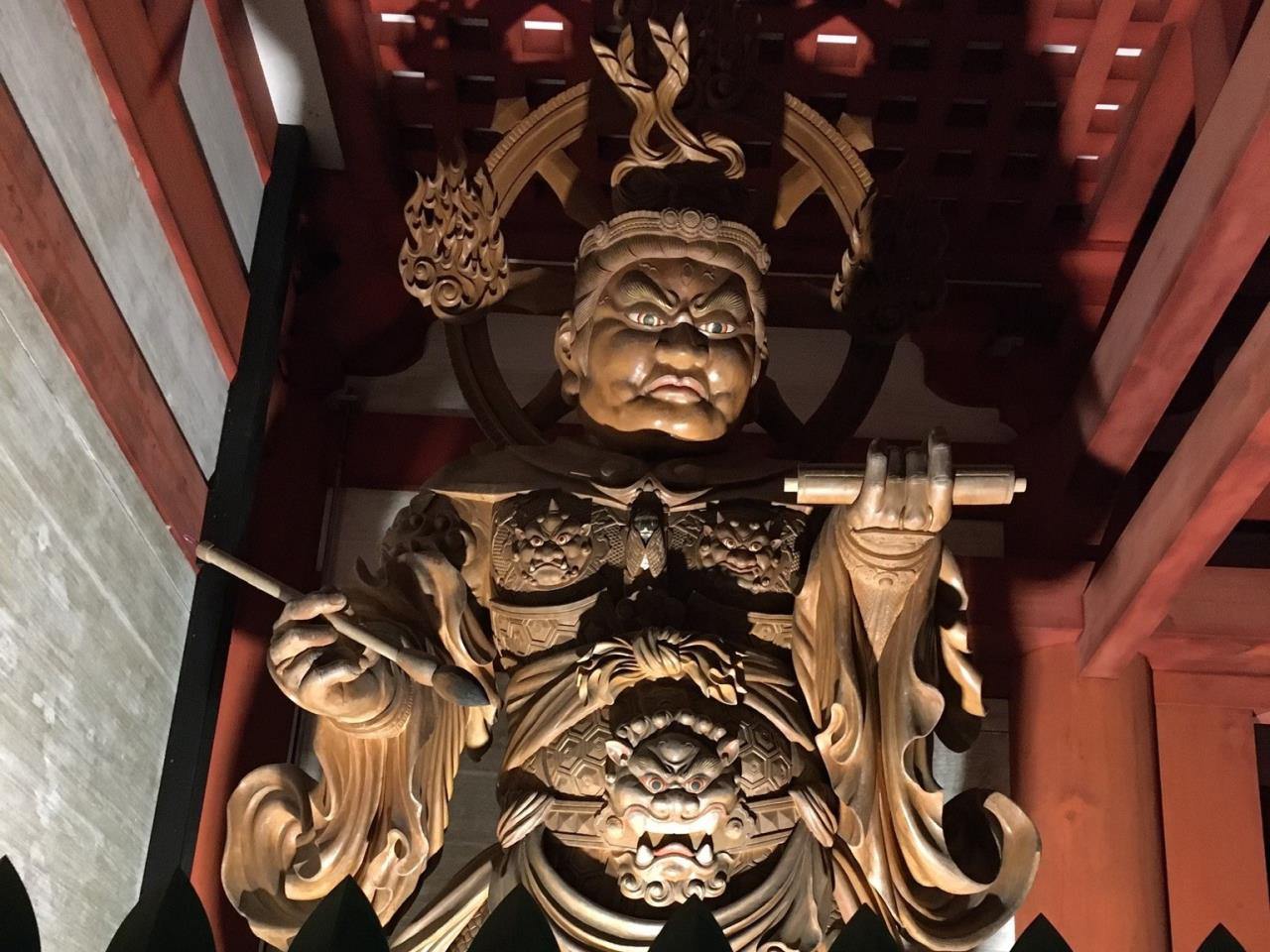
Temple Lodgings, Fukuchi-in
We arrived in Koyasan at dusk. Our lodgings for the night were to be Fukuchi-in, and we headed straight to the temple to check in.
The temple complex at Koyasan was founded by Kukai over 1,200 years ago in 816. The number of temples in the mountains has varied over the years. In the mid 19th century Koyasan had more than 800, but today that number has reduced to just 117, 51 of which offer overnight accommodation. Fu-kuchi-in, one of them, was established more than 800 years ago and worships Aizen Myoo, a Bud-dhist deity believed to bring good fortune, happiness, and the fulfillment of good relationships.
If you have never stayed at a temple, you would be forgiven for imagining the facilities might be sparse and basic, but although Fukuchi-in is a true working temple the lodgings are very comfortable and much like an up-market minshuku inn, complete with natural hot spring baths - the only ones in Koyasan. Unlike most minshuku, though, Fukuchi-in’s buildings are stunningly beautiful. Through the entrance gate guarded by two little ogres, you walk through an entrancing courtyard garden to the en-trance. A long corridor runs along the front of the main building connecting the main guest room area to the right, with a labryrinth of rooms to the left leading to the main temple building itself. The guest rooms are Japanese style with futons to sleep on, and the washing area, toilets and baths are commu-nal, like in many minshuku.

Danjo -Garan Night Tour Daimon Gate, Miyashiro Shrine
Once we had checked in and dropped our bags in our rooms, we headed out again for a night tour of the Danjo-Garan area, Koyasan’s central temple complex. This is the most sacred area of Koyasan, the area originally founded by Kukai for the training of Shingon Buddhism. Most of the buildings are re-constructions built at various times over the centuries, the originals having been lost to fires, and only the unassuming Fudo-do is original. The most impressive of the buildings is the huge central pagoda, similar in shape to the one at Negoro-ji Temple but constructed of reinforced concrete not wood, and painted a vivid red.
The main entrance to the Garan is the Chu-mon Gate, a massive wooden structure standing 16 meters high, and again painted a brilliant vermillion. The current gate is a reconstruction that was completed in 2015 to celebrate Koyasan’s 1,200 centennial, along with the two giant guardian deities that stand on either side. The guardians are extraordinary feats of carving by master buddhist carver Myokei Matsumoto. Like everywhere in the world, Japan’s traditional crafts are in gradual decline, but that there are still sculptors active in Japan capable of executing such exquisite work is testament to Ja-pan’s incredible tradition of craftsmanship and heritage. Although the gleaming, unpainted wood is obviously new, the two guardians are very much in keeping with similar ones from centuries ago. But, though contemporary, the detail and facial expressions must surely put them among the best examples of temple guardian statues found anywhere in Japan. And, in a modern and typically Japanese touch, each holds a symbolic metaphor on its chest - a dragonfly on the chest of the left guardian and a cica-da on the right. The dragonfly is known to only fly straight forwards, and so symbolizes determination and strength of will. And the cicada’s call is so loud it carries for miles around, a metaphor for how the guardian can see far into the distance.
At the far edge of the Garan complex, sitting quietly among a small thicket of trees, is a Torii gate, and beyond it two unassuming “temple” buildings. The Torii, of course, makes it clear that these are not temples at all, but rather Shinto shrines, and although they are perhaps not the most popular of the sites to see, they are in some ways among the most interesting. This is the Miyashiro Shrine, and its accompanying hall of worship, the Sanno-in Shrine, and their existence says much about buddhism in Japan, and its relationship with Shinto. When Kukai was looking for a place to practice his studies on his return from China, he came upon the mountain area that was to become Koyasan and decided to make it his base. But first, he had to ask the mountain gods - the Shinto gods, native to Japan - for permission, and the very first building he constructed in the area was not a Buddhist temple but a Shinto shrine dedicated to them. To this day, the shrine hall is used for important ceremonies by the monks, and as the shrine has no priest the monks themselves perform the necessary Shinto prayers and ceremonies.
Morning prayers
But Koyasan is of course a buddhist center, and we returned to Fukushi-in in time for our Shojin din-ner. Variations on Shojin food is eaten by Buddhist monks across Japan and much of Asia, and is be-coming more common in the west too with the rising popularity of vegetarian and vegan food. Alt-hough shojin food doesn’t actually proclaim itself vegan, in its pure form it uses no animal produce and is based mainly on a staple of rice and soy beans, with a variety of seasonal vegetable dishes and stock made from seaweed and mushrooms. Centuries of development mean even for a hardened meat-eater a full shojin meal will leave you thoroughly full and satisfied. Unless you are in Koyasan for serious spiritual practice, you are welcome to order beer or sake with your meal, though, which on Koyasan are quaintly known not as sake (alcohol) but as “hannyato”, or “hot water of prajna wis-dom”. After a delicious and filling meal we retired to bed early, so as to be able to get up ready for morning prayers at six.
The next morning just before six I made my way along the temple corridors to the entrance to the main hall itself at the very back. At the door we were greeted by a young monk, who showed us how to take a pinch of powdered incense and rub it into our palms to cleanse ourselves before we entered the prayer hall. It was still cold, and the heater in the center of the prayer room was most welcome, as too were the low stools so we didn’t have to kneel or sit crosslegged through the prayer service and risk losing all circulation in our legs. The head monk and his two assistants were separated from us by a decorative screen, with a smoking incense bowl in the center, and beyond the elaborate gold statues and furnishings of a Buddhist altar gleaming in the candlelight. The prayer service itself was led by the head monk chanting prayers punctuated by bells, gongs and cymbals and further chanting from the other monks in a complex, overlapping pattern. Even to the uninitiated, the heady scent of the incense and repetitive chanting echoing around the hall soon pulls you into a gentle trance-like state and it is easy to see how with practice this could aid you in meditation. The service does not last long, and we were quite soon making our way back to our dinner room where a delicious shojin breakfast was wait-ing. Once we had eaten, we strolled back through the corridors once more to a small room with sofas looking out on a courtyard garden, for a very welcome cup of coffee.
Mirei Shigemori Gardens
It was this garden, and two others in different areas of the temple, that were the main reason for us choosing Fukuchi-in as our hotel for the night. All three were designed and built by Mirei Shigemori, one of the most famous gardeners of the 20th century. Like many of Mirei’s gardens, they are charac-terized by their powerful geometric masonry and bold use of planting.
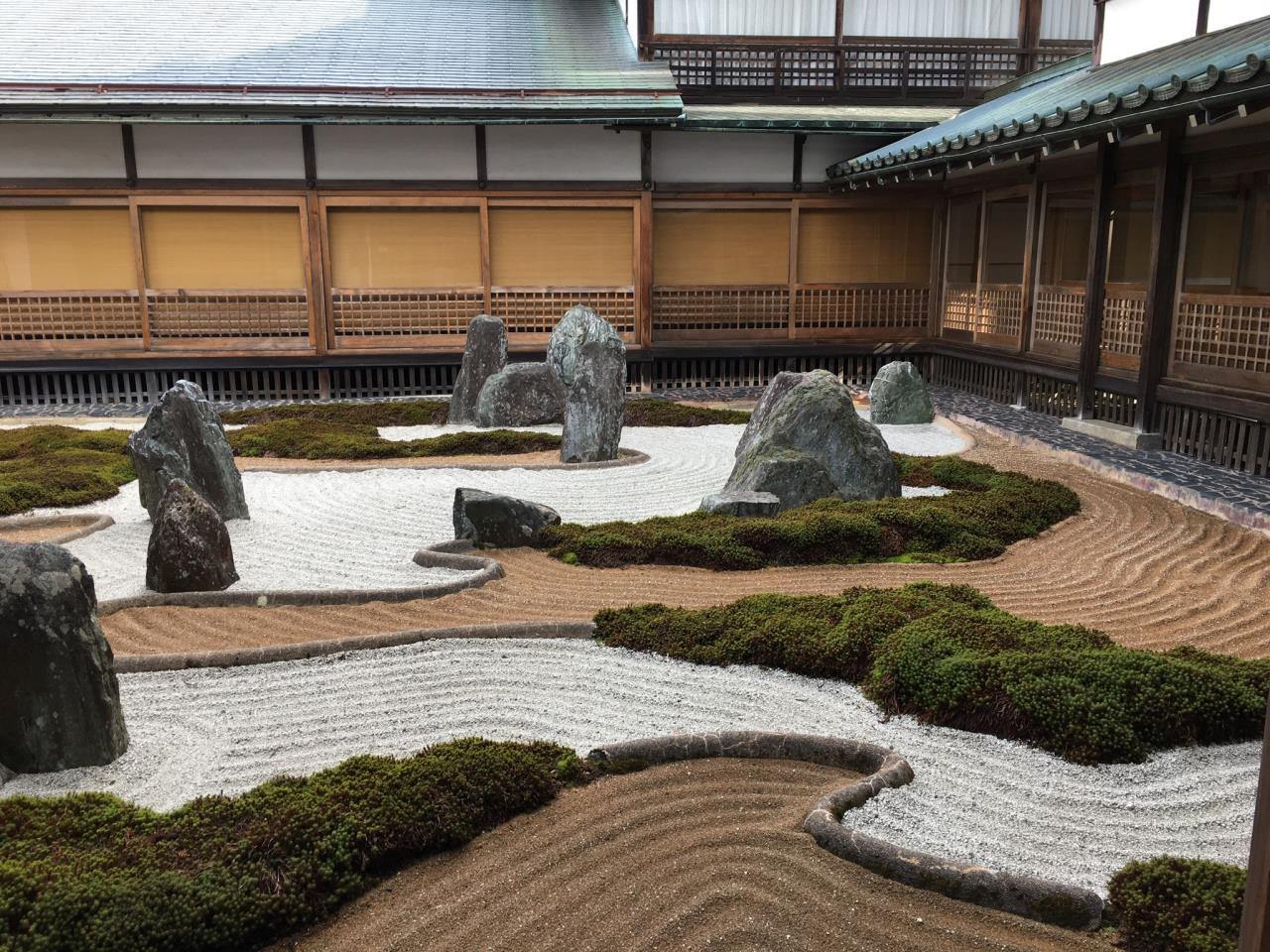
When we had finished our coffee, the head monk appeared to take us on a tour. The smallest of Mirei’s garden that we had been enjoying with our coffee is a stone garden charmingly called the Hermit’s Playground. The dry landscape is enclosed on three sides by buildings, with the far left cor-ner running off out of sight, and represents the ancient Chinese legend of "Horai Island” - an idyllic place where immortals are said to live in the far East Seas. The ground is separated into swirling patches of red and white gravel, separated by low concrete boundaries and punctuated by mounds of moss and fifteen careful placed stones. The stones represent the tips of mountains, and as you con-template the garden you can imagine the immortal hermits of Horai flying from one mountain top to another in a fantastic, playful game of cat and mouse.
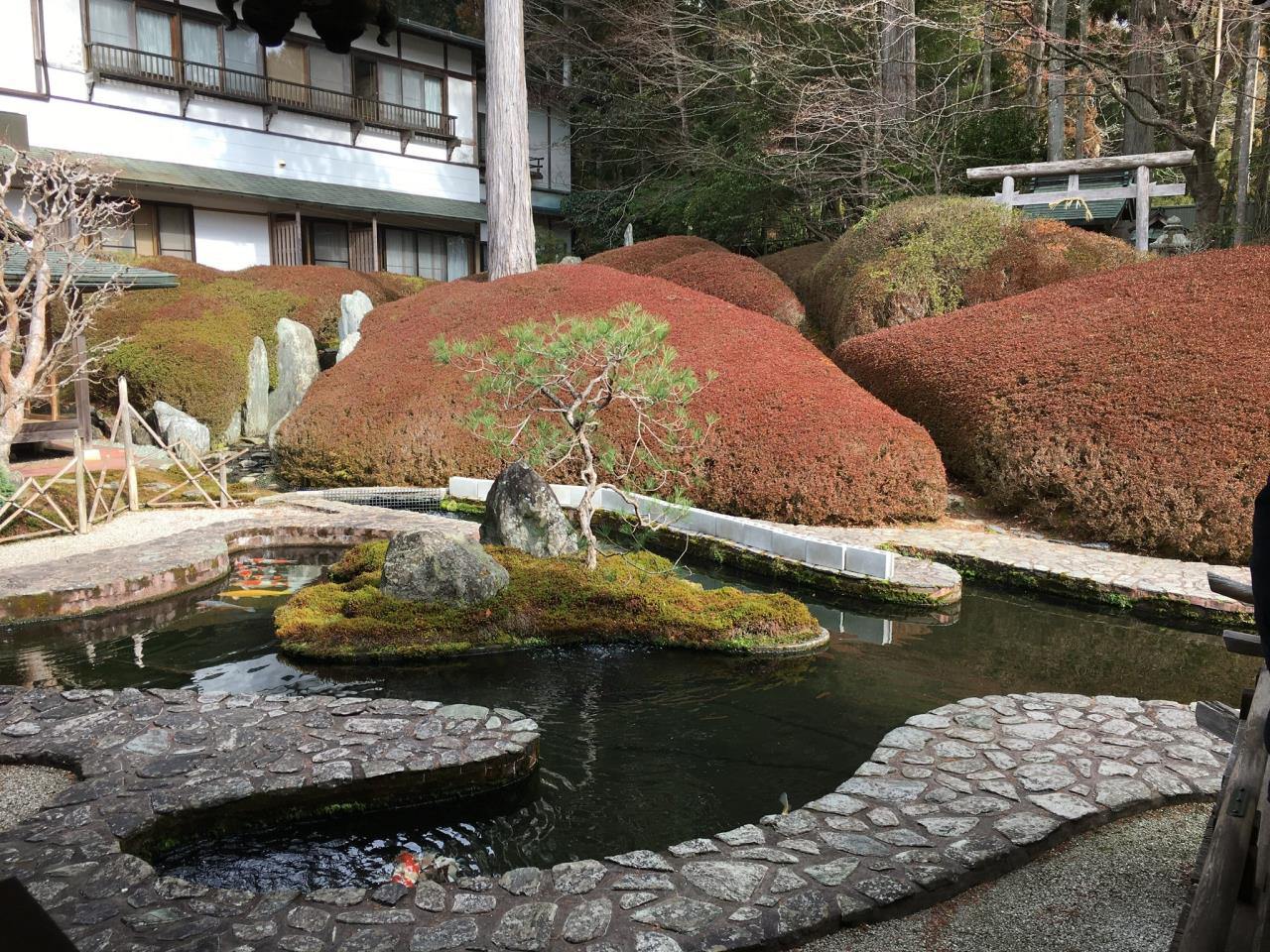
A little further along the corridor is Tosentei. This garden is modeled after the famous Dragon Gate Waterfall. Great mounds of carefully shaped azaleas make the shapes of gently sloping distant moun-tains, again depicting the Horai mountain range. The shape of the pond and fountain in the fore-ground, bounded by crisp cobbled stones and raked gravel, is entirely modern, but the depiction once again of the crane and turtle islands shows how Mirei expressed traditional motifs in a 20th century style.
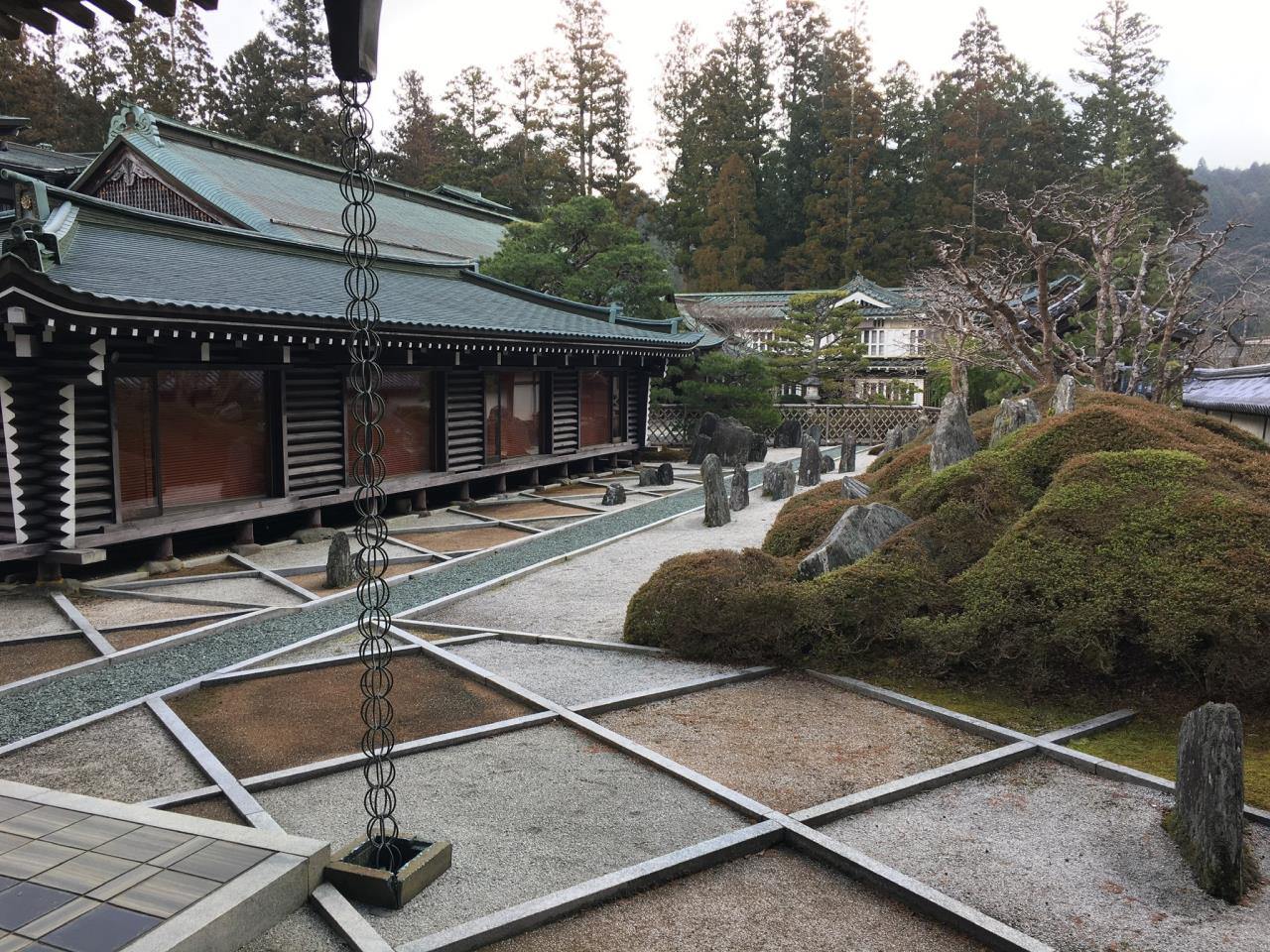
The most spectacular of Fukuchi-in’s gardens is the Aizen Garden, named after the Fukuchi-in deity Aizen-Myoo, and it is best viewed from the temple hall. This is said to be the last garden constructed by Mirei himself shortly before his death in 1975. Sadly, due to corona, the temple had been unable to rake the garden into its full patterned glory when we visited, but even unraked the bold, geometric pat-tern of red and white sand, again with a “mountain range” of trimmed azaleas and perfectly placed rocks, was spectacular. This is undoubtable a modern classic, and for lovers of 20th century modern-ism is reason enough alone to chose Fukuchi-in as your place to stay in Koyasan.
Kongobu-ji Temple, Okuno-in, Forest Therapy
After we had checked out, we headed back into the center of Koyasan to Kongobu-ji Temple, the head temple of Koyasan. Kongobu-ji was founded in 1593 by Toyotomi Hideyoshi to commemorate his deceased mother, and became the head temple of Koyasan in 1869, and in 1946 the head of 3,600 Koyasan Shingon temples across Japan. At the entrance we were met by Kokan Nakamura, the monk who was to be our guide. Nakamura-san led us through the endless rooms of the temple, each decorat-ed with extraordinary painted screens making the whole building as much an art gallery as a temple. Our first destination was the Banryu-tei Garden , reached across a bridge corridor from the main build-ing. Like Mirei’s gardens at Fukuchi-in, Banryu-tei, too, is a modern garden, completed in 1984, 1150 years after Kukai passed into the next life. Said to be the largest dry garden in Japan, it is extraordinar-ily bold, studded with massive rocks that create the rough outline of two enormous dragons storming across the main garden area and wrapping their long tails around buildings and under walkways. Amazingly, although the date of its construction is clear and really very recent, and the symbolism of the rocks, too, well understood, there is no record of who built Banryu-tei, so it remains a rather per-plexing puzzle.
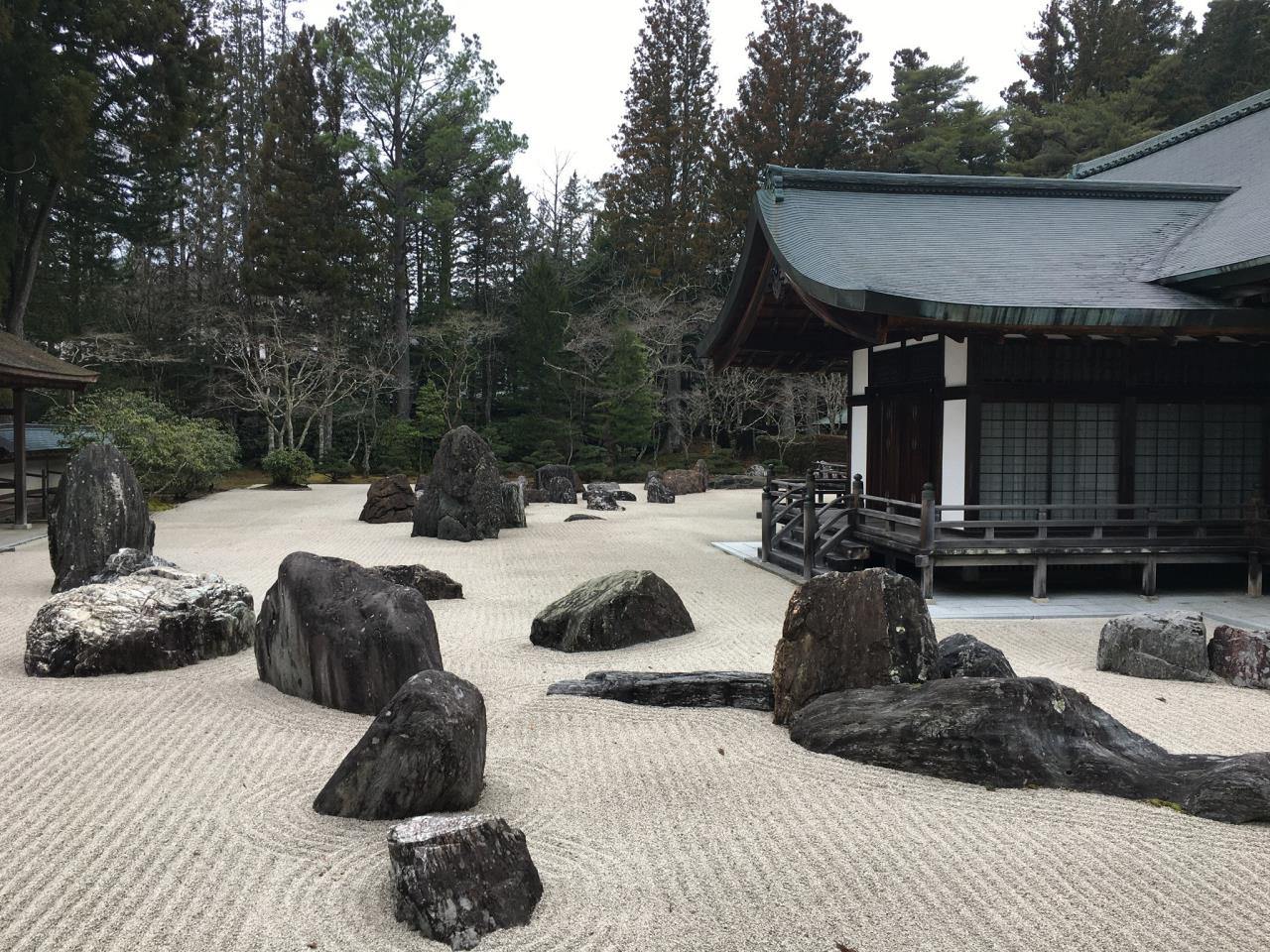
Back along the corridor to the main temple building we walked through the vast old kitchen area with its huge wood-fired “kamado” ovens and, unusually for a Japanese building, enormous plastered chimney, to the central rooms, and the contemporary centerpiece of Kongobu-ji. Each of the huge central room has screens painted by contemporary artist Senju Hiroshi, which went on display in 2020. These enormous but deceptively simple black and white depictions of forests, rocks and water-falls are truly spectacular. That Kongobu-ji temple commissioned them is another wonderful example of how one of Japan’s most ancient temple complexes continues to update itself and remain relevant even in modern times.
It was time for lunch, and so we headed to Bon On ShyA International Cafe, a little cafe restaurant run by a Japanese man and his French wife, that serves delicious western style vegetarian and vegan meals with a Japanese touch. After lunch and an excellent cup of coffee, we were charged and ready to head on for a walk through the Okuno-in to the mausoleum where Kukai, or Kobo Daishi as he is known since his passing, is said to be sitting in eternal mediation.
The Okuno-in is a 2 km path through Japanese cedar woods filled with over 200,000 tomb stones. Re-cently night tours have become popular with foreign visitors, much to the surprise of the more super-stitious local Japanese who will generally avoid graveyards at all cost, although these stones are me-morials not actual graves. But the walk is certainly a little creepy, and personally I was quite happy to be visiting in the daylight.
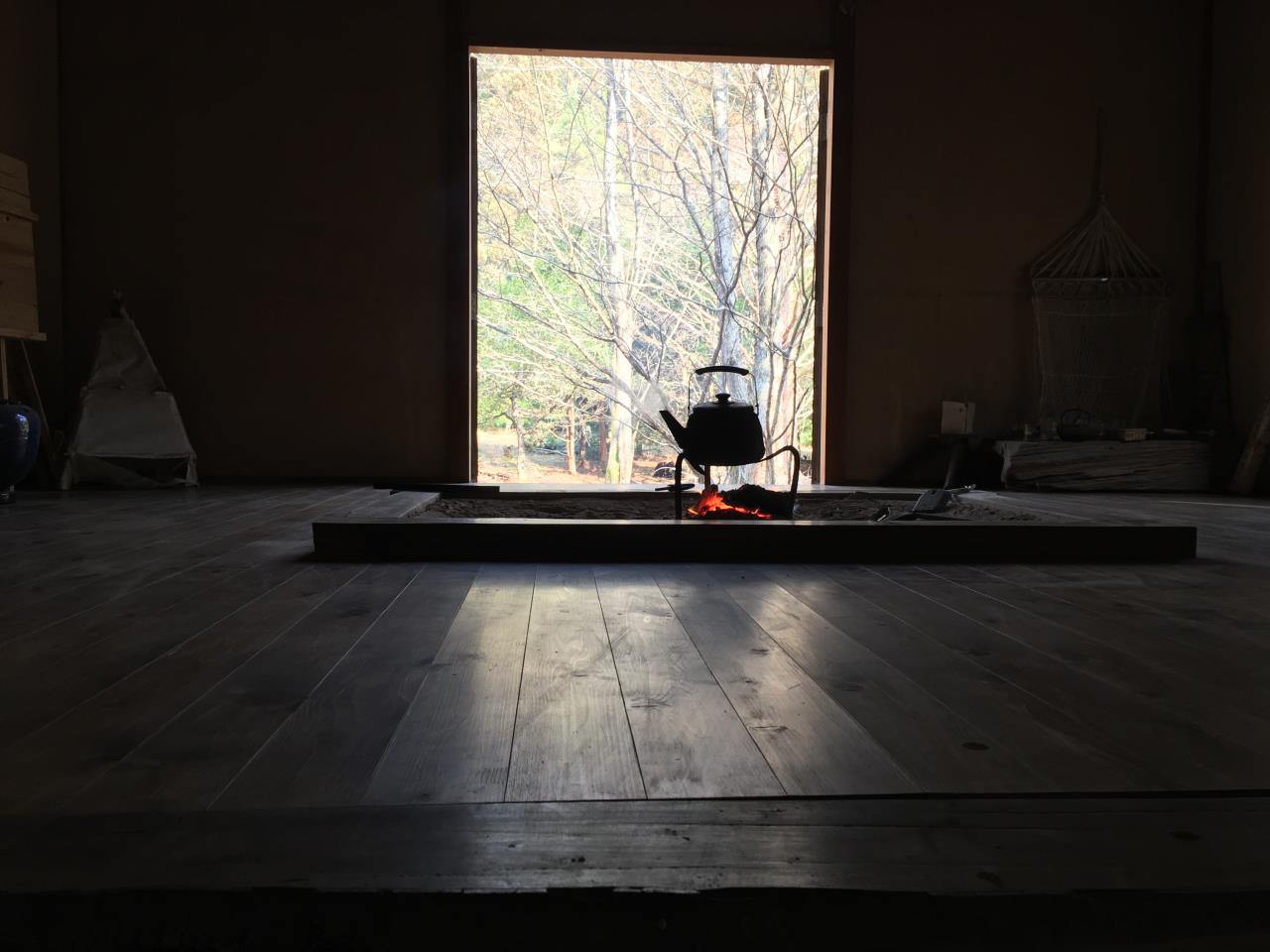
At the end of the pathway we paid our respects to Kobo Daishi at the mausoleum, and then carried on beyond where were met by local foresters who were to take us further into the woods. A quick car ride up the road and we found ourselves at a small car park at the entrance to the forest, and from there a short 10 minute walk brought us to a pretty clearing with a foresters hut, and hammocks strung between the trees. Koyasan is known for its temples and buddhist practice, of course, but if you tire of incense and history and long to get out into the nature that surrounds you in the mountains, you can join a forest therapy group and spend a day in the great outdoors. The hut has a wonderful irori fire-place dug into the floor, and a cup of tea by the fire was enough to entice me into one of the ham-mocks. If we hadn’t had to catch a train home I could have happily spent the rest of the day there, just listening to the birdsong and contemplating the clouds.
But it was time to go home, and so we headed to the station. I had arrived with my guides by car, but planned to go home by train, which meant first of all riding the funicular railway down the mountain side to the main train station at the bottom. From there a modern express train runs around the moun-tain side with spectacular views across misty valleys and mountain villages until eventually you get down to the lowlands once more. And before I knew it I was back in the busy bustle of Osaka, with only the smell of incense in my clothes and hair to remind me that the last few days were not a dream…
Check also...
![Take a leisurely stroll in the retro and fashionable space [Kuroe, the town of Kishu lacquerware]](/kansaiguide/data/article/21000/20278/20250618_133123_770e1e88_w640.webp)
Take a leisurely stroll in the retro and fashionable space [Kuroe, the town of Kishu lacquerware]

Consider your accommodation in the Kansai area!

Restrictions on Large Baggage

Hidden Stories in Stone: Exploring Japan’s Castle Walls

Feel Like a Lord: Castle with Stunning Panorama Views

Experience the True Essence of Japan through Castles, Cultural Treasures, and Timeless Gardens
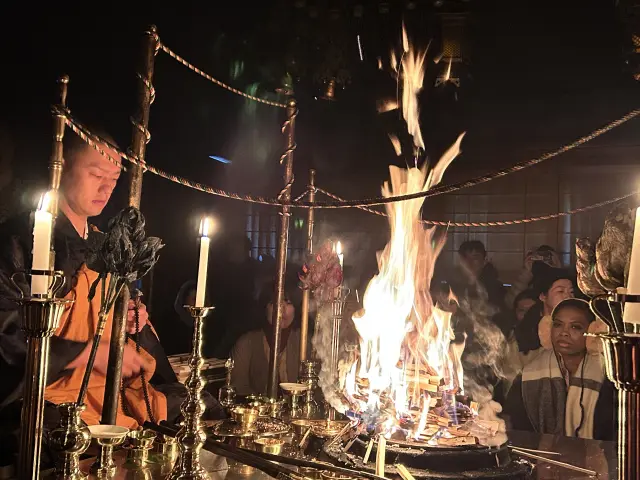
Departing from Osaka, Exploring Wakayama and Tokushima: A Journey Connecting Mountains and Sea with a Focus on Mindful Sustainability
